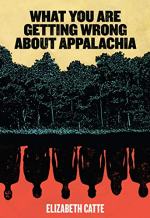
|
| Name: _________________________ | Period: ___________________ |
This test consists of 5 multiple choice questions, 5 short answer questions, and 10 short essay questions.
Multiple Choice Questions
1. Bo Copley became a "coal country celebrity" (50) after a tense encounter with which politician?
(a) Donald Trump.
(b) Hillary Clinton.
(c) Ben Carson.
(d) Marco Rubio.
2. Catte laments that the memoir Hillbilly Elegy is populated by men who take what action?
(a) Shirk employment.
(b) Commit acts of violence.
(c) Hate their culture.
(d) Embrace their powerlessness.
3. What attitude are the coal companies said to have exhibited toward organized labor unions?
(a) Strong hatred.
(b) Violent hysteria.
(c) Cunning strategy.
(d) Reluctant tolerance.
4. The University of Chicago's S.S. MacClintock wrote about the Hatfield-McCoy feud in which journal?
(a) American Journal of Sociology.
(b) American Journal of Cultural Anthropology.
(c) American Journal of Criminal Law.
(d) American Journal of Psychology.
5. Catte laments the tradition of "casting Appalachia as what kind of 'other America'" (8)?
(a) Backwards.
(b) Monolithic.
(c) Illogical.
(d) Progressive.
Short Answer Questions
1. Catte and her partner moved from one state to another how many months before the 2016 presidential election?
2. Catte characterizes Hillbilly Elegy's portrayal of Appalachians in all but which of the following ways?
3. Which two ethnic groups are said to "have fueled more than half of Appalachia's population growth" (10)?
4. What website "began running predictions that treated Appalachia as one very large state" (35) during the 2016 presidential campaign?
5. What video game is said to contain a reference to the Hatfield-McCoy feud?
Short Essay Questions
1. Provide the facts of the most basic interpretation of the Hatfield-McCoy feud.
2. What evidence does Catte use to support her claim about the environmental problems in Texas?
3. What does Catte mean when she names the "clinical" (7) reasons for her move out of Appalachia?
4. In what decade was a government-funded visual archive of Appalachia created and what was its central focus?
5. What strategy does Catte present as part of her plan of action for living in "Trump Country" (52) and what actions does she say she will refrain from taking?
6. In what way does Catte use the metaphor of a mirror to characterize the Appalachian identity?
7. What action is suggested as "making it easier to paint Appalachians as perpetual victims" (52) and why?
8. What is the significance of the term "Murderland" (40) when used by T.C. Crawford?
9. What are Catte's two objectives within What You Are Getting Wrong About Appalachia?
10. What is Catte's main claim about the problems of the Appalachia region?
|
This section contains 1,166 words (approx. 4 pages at 300 words per page) |

|




